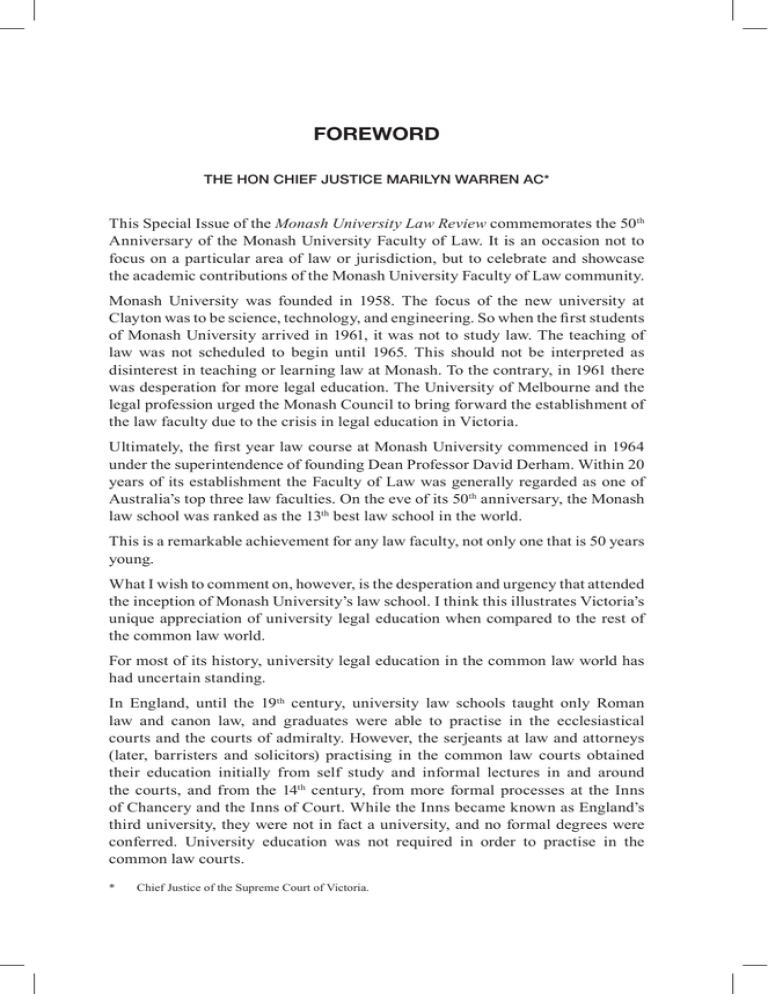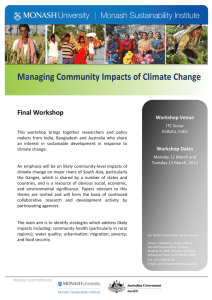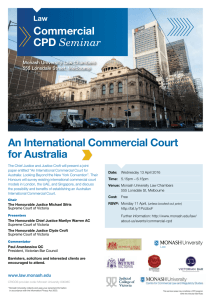FOREWORD
advertisement

FOREWORD THE HON CHIEF JUSTICE MARILYN WARREN AC* This Special Issue of the Monash University Law Review commemorates the 50th Anniversary of the Monash University Faculty of Law. It is an occasion not to focus on a particular area of law or jurisdiction, but to celebrate and showcase the academic contributions of the Monash University Faculty of Law community. Monash University was founded in 1958. The focus of the new university at Clayton was to be science, technology, and engineering. So when the first students of Monash University arrived in 1961, it was not to study law. The teaching of law was not scheduled to begin until 1965. This should not be interpreted as disinterest in teaching or learning law at Monash. To the contrary, in 1961 there was desperation for more legal education. The University of Melbourne and the legal profession urged the Monash Council to bring forward the establishment of the law faculty due to the crisis in legal education in Victoria. Ultimately, the first year law course at Monash University commenced in 1964 under the superintendence of founding Dean Professor David Derham. Within 20 years of its establishment the Faculty of Law was generally regarded as one of Australia’s top three law faculties. On the eve of its 50th anniversary, the Monash law school was ranked as the 13th best law school in the world. This is a remarkable achievement for any law faculty, not only one that is 50 years young. What I wish to comment on, however, is the desperation and urgency that attended the inception of Monash University’s law school. I think this illustrates Victoria’s unique appreciation of university legal education when compared to the rest of the common law world. For most of its history, university legal education in the common law world has had uncertain standing. In England, until the 19th century, university law schools taught only Roman law and canon law, and graduates were able to practise in the ecclesiastical courts and the courts of admiralty. However, the serjeants at law and attorneys (later, barristers and solicitors) practising in the common law courts obtained their education initially from self study and informal lectures in and around the courts, and from the 14th century, from more formal processes at the Inns of Chancery and the Inns of Court. While the Inns became known as England’s third university, they were not in fact a university, and no formal degrees were conferred. University education was not required in order to practise in the common law courts. * Chief Justice of the Supreme Court of Victoria. Foreword – The Hon Chief Justice Marilyn Warren AC 5 Despite the introduction of common law courses to English universities in the 19th century, a university degree in law remains unnecessary to practise in England. For a long time, the situation was similar in North America, New Zealand, and parts of Australia. Victoria was different. The Supreme Court of Victoria was established in 1852 (a Supreme Court having sat in the colony since 1841). From its creation it had the power to regulate the admission to practice of barristers and of ‘attornies solicitors and proctors’, and also the qualification of candidates. From 1857 the Supreme Court’s admission rules exempted law graduates from the Court’s admission exams. Studying law at university was therefore placed on an equal footing with the alternative route of self-study, apprenticeship and sitting the Court’s exams. In 1872, the Supreme Court judges went even further and made a full bachelor’s degree in law a prerequisite for admission to the bar. This requirement was unique in the common law world. The first American state to require candidates for admission to have a law degree did so in 1927. So it was in a State where university legal education has, for almost all of its history, had a certain and valued standing, that the Monash University Faculty of Law was established. The Faculty of Law at Monash University has continued and contributed to the proud tradition of higher legal education in Victoria. To celebrate this contribution, this Special Issue features judicial addresses by the Honourable Chief Justice French, the Honourable Justice Bell, and me, then a selection of articles by some of the eminent alumni and past and present academic staff of Monash University. Emeritus Professor Ron McCallum AO and others explore the significance of the Convention on the Rights of Persons with Disabilities for international law. He studied law at Monash University, and then lectured there from 1973 to 1994. He is now Chair of the United Nations Committee on the Rights of Persons with Disabilities. Professor Anthony Duggan compares the Australian and Canadian personal property security regimes and evaluates alternatives. Professor Duggan held the Henry Bournes Higgins Chair in Law at Monash University from 1990–1999, and now works at the University of Toronto. Professor Jeffrey Goldsworthy analyses the High Court’s reasoning in Kable and Kirk, and considers the place of judicial statesmanship. He has worked at Monash University since 1984 and was appointed to a Personal Chair in 2000. Associate Professor Sarah Murray discusses the scope for revisiting the High Court’s approach to Chapter III of the Commonwealth Constitution. She completed a PhD at Monash University in 2011, and now works at the University of Western Australia. Associate Professor Matthew Groves writes on the topic of public statements by the judiciary and the implications of such statements for the bias rule. He was awarded a PhD at Monash University in 2003 and is now an Associate Dean of the Monash University Faculty of Law. 6 Monash University Law Review (Vol 40, No 1) Mr Liam O’Brien contributes a case note on Aytugrul v The Queen. He represents the current law students at Monash University. The edition ends with a review of Dr Ronli Sifris’s book entitled Reproductive Freedom, Torture and International Human Rights: Challenging the Masculinisation of Torture. Dr Sifris obtained an LLB and a PhD from Monash University, where she now works. The 50 years of academic contribution by the Monash University Faculty of Law so far founds great anticipation for the 50 years to come.




